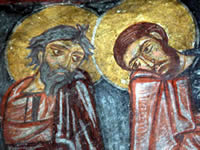DAILY BLUE TOUR DETAILS

MUSTAFAPASA (SINASSOS) town remained predominantly Christian throughout the Seljuk and early Ottoman periods, although the Muslim population increased from then on. The Byzantine Greek (Christian) population in the area kept alive their language over the centuries and even developed their own unique dialect. Sinasos, the Greek name for the town, became wealthy by trading with Istanbul, and some splendid old stone Greek houses rich in decoratively carved symbols are not to be missed.

KESLIK MONASTERY, situated in a paradise–like green valley, contains the Church of the Archangel, the Chapel of Saint Stephen, a huge dining area, living quarters and a pool of sacred water. The monks and their guests could hide from danger in a room secured by two mill–stone doors, and a secret passage and spy–hole next to this room would have allowed one of the senior members of the monastic order to secretly listen in on their conversations! The Church of the Archangel is one of the few cave churches to have been used by the local population into the twentieth century.

TASKINPASA takes its name from the Turkish philosopher, Tashun, who taught in the now ruined local Medrese (Madrasa or Islamic Theological School). The Medrese building, the nearby mosque and Tashun Pasha’s tomb were built in the 14th century by the Karamanids using classical Seljuk style stone decoration. You will be amazed by the detail of the stonework on the Medrese doorway.

SOBESSOS is a newly discovered Roman–Byzantine wealthy city just outside Sahinefendi village. We are very excited about this as nothing so big has been found in the region before. You can see the remains of the 4th century baths with its mosaic of a pair of sandals, and the huge 6th century church with a geometric mosaic floor. It says on the Internet that it could one day rival Ephesus — while this is probably an exaggeration, it nevertheless emphasizes the importance of this ancient town.

SOGANLI, which directly translated means "Land of Onions", is the last of the line of villages in the valleys south of Urgup, and really the most traditional one. Once again, people have built homes in the rock cones created as erosion swept down the hillsides, and until a few decades ago it was home to the highest number of dovecotes in the region, providing guano for the fields around. Its isolation meant it was the ideal place for Byzantines to build monasteries, which were inhabited until at least the 1750s.

Today, the visitor can enter several churches with reasonably well preserved wall paintings dating from the 10th to the 13th centuries. The locally made doll is the emblem of the village, but this symbol originated from a tragic event: a local woman lost her baby and, unable to cope emotionally, made a rag doll to take its place. Later on, the women of the village developed the art of making these dolls while their men were out on the mountains grazing their animals. A Soganli doll is a must for every doll collection.